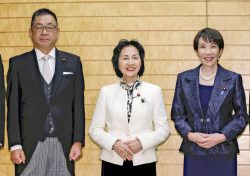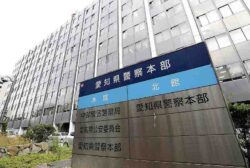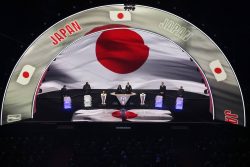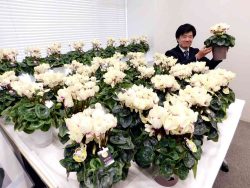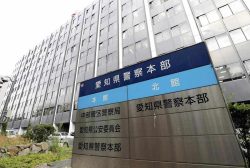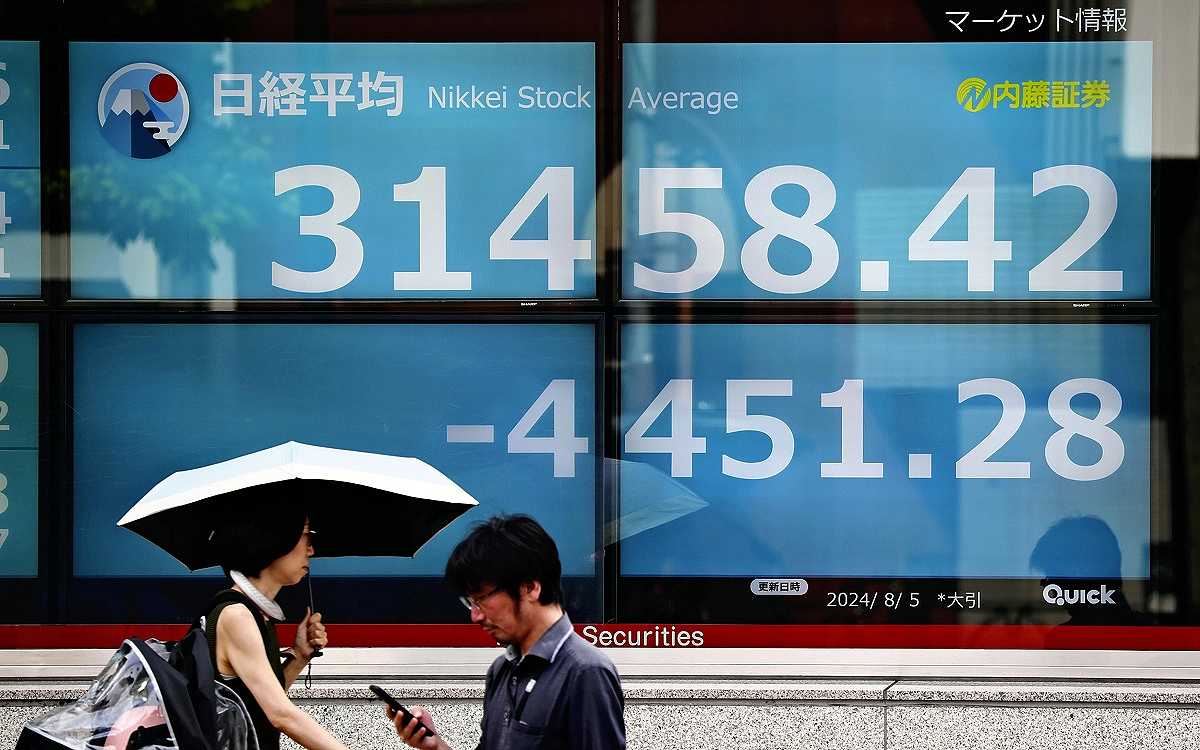
A monitor showing the Nikkei Stock Average’s largest-ever decline on Aug. 5 in Chuo Ward, Tokyo
8:00 JST, August 17, 2024
Last week, the Tokyo stock market experienced historic volatility. The Bank of Japan’s dialogue with the financial markets, which contributed to the turbulence, left a big question mark.
The benchmark Nikkei 225 index plunged a record 4,451 points on Aug. 5 to close at 31,458, a drop that exceeded the Black Monday stock market crash of Oct. 20, 1987. The next day, the Nikkei closed at 34,675, up 3,217 from the previous day’s close, a record increase from one closing to the next.
Since the beginning of this year, the Nikkei has been in an overheated environment and is prone to entering an adjustment phase.
In the spring of 2023, the Tokyo Stock Exchange said it would focus on the price-to-book ratio, which indicates whether a stock is undervalued or overvalued. This policy would require companies to formulate improvement plans to revitalize the market further.
In 2024, an expansion of the Nippon Individual Savings Account program (NISA), in which income from small investments is tax-exempt, has attracted new individual investors and positively affected the Japanese stock market.
The Nikkei began this year at about 33,000 and then began a marked rise. On Feb. 22, it hit its then all-time high of 39,098, breaking the bubble-era record of 38,915 set on Dec. 29, 1989. In the following months, it rewrote the record again and again until hitting its latest all-time high of 42,224 on July 11.
The New York stock market was also overheated. On July 17, the Dow Jones Industrial Average closed at an all-time high of 41,198.
Several factors contributed to the overheating of the stock market.
The Federal Reserve raised its benchmark overnight interest rate to 5.25%-5.50%. However, the U.S. economy had remained surprisingly strong without significantly slowing.
Investors expected the stock market to continue rising, driven by the boom in generative AI and semiconductors. For foreign investors, the weak yen has made Japanese equities a bargain, and money was flowing into the Japanese stock market.
Skepticism about such favorable conditions triggered a historic decline in stock prices.
A U.S. employment report released on Aug. 2 fell far short of market expectations, intensifying fears of a recession.
Some have come to believe that growth expectations for AI were also excessive.
Furthermore, the Bank of Japan’s monetary policy significantly impacted Japanese equities, causing a simultaneous global stock market decline.
The BOJ raised its policy rate from the 0.0%-0.1% range to 0.25% on July 31. Gov. Kazuo Ueda made his hawkish stance toward tighter monetary policy clear at a press conference, and the yen, which had become weaker than ¥160 to the dollar in July, surged to the ¥141 level.
Until now, the weak yen had boosted the performance of export-oriented Japanese companies, but now that the yen has reversed to a strong position, investors are concerned that the performance of such Japanese companies will worsen.
It is essential to think about economic policy from the perspective that the Japanese economy is now trying to completely break away from the deflationary mentality and cost-cutting, contractionary tendencies that have gripped it for 30 years.
We should enter a new stage with sustainable wage growth; normalization of the BOJ’s monetary policy is appropriate for Japan’s economy.
In “a world with interest rates,” corporations must strive to earn returns that are greater than the interest rate, with their efforts to reach that goal leading to the revitalization of the economy through value-added goods and services. We are shifting from a “cost-cutting economy” in which labor costs are kept low and price hikes are avoided as much as possible, to a “growth economy” that also increases the added value of products and promotes investment in people.
However, it has been a long time since the Japanese economy became accustomed to a “world without interest rates.” The BOJ began a zero-rate era — not its first one — in October 2010 and introduced a negative interest policy in February 2016. Not until March this year did the BOJ lift its negative interest rate policy and enter a “world with interest rates.”
The BOJ should issue careful messages when raising interest rates to avoid surprising the financial markets.
However, in tightening monetary policy, the BOJ made two decisions that the markets did not expect.
Many in the financial markets expected the BOJ to lift its negative interest rate policy in April, but the BOJ brought the move forward to March. Also, many financial market participants expected an interest rate hike to 0.25% in the fall, but the BOJ raised the rate in July.
The BOJ moved up its decision both times from the financial market’s expectations because of its careful consideration of the political schedule, the state of the economy, and prices.
Although it was not highly likely, the April monetary policy meeting could have coincided with a general election. Also, the September meeting could have coincided with the LDP presidential election.
The financial markets reacted to the two decisions in contrasting ways.
Financial markets were calm immediately after the BOJ ended its negative interest rate policy in March because the bank did not take a hawkish stance toward tightening monetary policy but rather a dovish one of caution toward raising interest rates.
However, in its July decision, the BOJ raised interest rates earlier than the financial markets had expected and did take a hawkish stance, indicating a willingness to raise rates further in the future. This hawkish stance caused panic in the financial markets.
Perhaps considering criticism from politicians, the public and others that the excessively weak yen had led to high prices, the BOJ avoided taking a dovish stance as it had in March to discourage the yen from weakening excessively. However, this decision backfired.
BOJ Deputy Gov. Shinichi Uchida tried to change course in a speech on Aug. 7, saying: “We will not raise interest rates amid instability in financial and capital markets. For the time being, we need to continue monetary easing firmly at the current level.”
Rather than asking whether the BOJ tightened monetary policy too soon, the lesson should be that tightening without allowing financial markets to fully factor in the imminent change raises the risk of causing turmoil in financial markets.
Since the current Bank of Japan law was enacted in 1998, increasing the bank’s independence from the government, there have been two significant instances when politicians and economists criticized it for hasty monetary tightening.
In August 2000, the BOJ ended its zero-interest rate policy, which had been in place since February 1999. However, when deflation became more severe and threatened to disrupt the global economy, the BOJ was forced to return to a “world without interest rates” in the face of critical public opinion.
In March 2006, the BOJ lifted its quantitative easing policy. However, the consumer price index statistics were retroactively revised downward, and prices temporarily turned negative that year. This revision led to criticism that the BOJ had removed quantitative easing measures too quickly.
After the bubble economy burst, Japan suffered a long period of deflation from 1998.
Many economists argue that the BOJ tightened its monetary policy too hastily in 2000. A certain number of economists also criticize the 2006 decision. And the Japanese economy has yet to emerge fully from deflation.
The current process of monetary tightening is the Bank’s third attempt to completely break free from deflation and could be a significant turning point for the Japanese economy.
Also, the next anticipated policy rate raise would be the third one in this normalization process.
Will the third time be the charm?
In the financial markets, there is speculation about whether the BOJ will raise interest rates further before the end of the year.
Meticulous dialogue between the BOJ and the financial market is crucial to breaking out of deflation entirely, achieving the 2% price stability target, and ushering in a new era for the Japanese economy.
Of course, if the BOJ were to raise interest rates again, it would need to choose an appropriate time based on a deep analysis of price trends and lessons learned from the past.
Political Pulse appears every Saturday.

Akihiro Okada
Akihiro Okada is a vice chairman of the editorial board for The Yomiuri Shimbun.
"Editorial & Columns" POPULAR ARTICLE
-

Corporate Interim Earnings: Companies Must Devise Ways to Overcome Trump Tariffs
-

Violations of Subcontract Law: Major Automakers Must Eliminate Old Practices
-

Local Governments’ Tax Revenues: Devise Ways to Correct Imbalances in Tax Sources
-
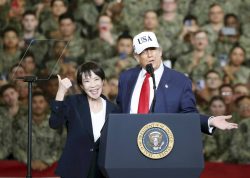
Takaichi’s Summit with Economics-Minded Trump Successfully Advanced Japan’s Security Interests
-

New Nuclear Threat: China Seeking to Follow U.S., Russia in Military Expansion
JN ACCESS RANKING
-

Govt Plans to Urge Municipalities to Help Residents Cope with Rising Prices
-

Japan Prime Minister Takaichi Vows to Have Country Exit Deflation, Closely Monitor Economic Indicators
-

Japan to Charge Foreigners More for Residence Permits, Looking to Align with Western Countries
-

Essential Services Shortage to Hit Japan’s GDP By Up to ¥76 Tril. By 2040
-

Japan GDP Down Annualized 1.8% in July-Sept.



